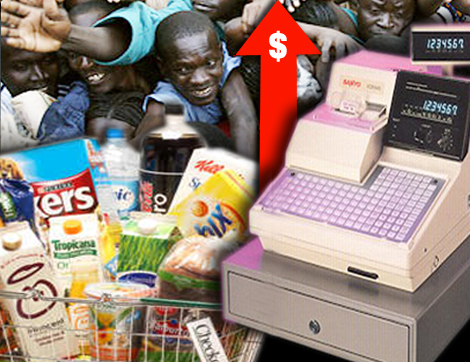
• Midwest droughts, growing unrest in the Middle East have prognosticators worried
By Keith Johnson
The worst United States drought since 1936 has devastated crops and livestock across the country and opened the floodgates to opportunists hawking genetically modified (GM) seed products. Worse yet, socioeconomic experts now predict that the world may be less than one year away from a catastrophic food crisis that could lead to even more political instability and civil unrest.
Meanwhile, consumers are bracing for a harsh winter as food prices begin their rise to unprecedented levels. Meat and dairy products, which account for 52% of the world’s food basket, are expected to become far more expensive over the next several months as farmers around the globe continue to slaughter millions of hogs, dairy cows and steers because they cannot afford the corn and soybean products used to make feed. It has gotten so bad that, in several cases, farmers have even been adding candy to cattle feed because of rising grain prices.
According to analysts at Rabobank, a leading agricultural investment house: “There will be an initial glut in meat availability as people slaughter their animals to reduce their feed bills. But by next year herds will be so reduced that there won’t be enough animals to meet expected demand, and prices will soar.”
Rabobank predicts that this herd liquidation will ultimately lead to a 14% jump in overall food prices, by June 2013. If correct, the price for a basket of food commodities will climb to a record 243 points on the UN Food and Agriculture Organization (FAO) index. This would be a historic high, and 175% higher than any previous level reached this century.
This is not to be taken lightly. According to a recent report from the New England Complex Systems Institute (NECSI), “high global food prices are a precipitating condition for social unrest. More specifically, food riots occur above a threshold of the FAO price index of 210.” NECSI is made up of academics from Harvard and MIT, who specialize in predicting how changes in environment can lead to chaos and upheaval, among other things.
Researchers at NECSI found that “the timing of violent protests in North Africa and the Middle East in 2011 as well as earlier riots in 2008” both coincided “with large spikes in global food prices” that sent the FAO to a high of 238. They now say that conditions are ripe for a repeat, and predict that soaring food prices will again lead to worldwide food riots by August 2013.
“Recent droughts in the Midwestern United States threaten to cause global catastrophe,” says NECSI President Yaneer Bar-Yam in a July 2012 report — The Food Crises: The U.S. Drought. “We are on the verge of another crisis, the third in five years.”
Not everyone is expected to suffer. In a recent Los Angeles Times article, entitled “As drought hits corn, bio-tech firms see lush field,” Ricardo Lopez writes: “Agricultural biotechnology companies have been pouring hundreds of millions of dollars into developing plants that can withstand the effects of a prolonged dry spell. Monsanto, based in St. Louis, has received regulatory approval for DroughtGard, a corn variety that contains the first genetically modified trait for drought resistance.”
Fortunately, the article went on to point out: “Skeptics of GMO crops say Monsanto and other firms may cause more harm than good, particularly to the environment. Studies have shown super weeds have begun choking millions of acres of farmland. These weeds have developed resistance to certain herbicides—much like the genetically manipulated corn and soybean varieties that dominate the seed market.”
Global food traders are also cashing in. In August, Chris Mahoney, the multimillionaire director of agricultural trading at Glencore International plc, a commodities trading company, outraged many when he said that that the U.S. drought was “good” for business. “The environment is a good one,” said Mahoney. “High prices, lots of volatility, a lot of dislocation, tightness, a lot of arbitrage opportunities.”
If there is any silver lining to the impending crisis, it is that Americans may soon learn to value corn as a food staple rather than a fuel product. Currently, almost 40% of all corn harvested in the U.S. is used to produce ethanol. This would not be the case were it not for the Environmental Protection Agency’s Renewable Fuels Standard (RFS). Each year, the RFS requires petroleum blenders to dilute their gasoline products with ever-increasing amounts of ethanol. For 2012, this includes 13.2 billion gallons of corn-derived ethanol.
“The math is fairly straightforward,” says Pete Sepp, executive vice president of the National Taxpayers Union. “Growing ethanol mandate plus dwindling ethanol crop equals shortage of whatever’s left over. The bottom line is potentially major price hikes on everything from tortilla chips to turkeys. In fact, a study from three Purdue University economists suggests that cutting back on the fuel mandates could reduce food prices by as much as 20% in the year 2013.”
Making ethanol from other plants besides corn certainly makes sense. There are many alternatives, such as certain other grasses, hemp and algae, that are higher in sugar and can produce ethanol more cheaply than corn.
Keith Johnson in an investigative journalist and creator of the Revolt of the Plebs.

